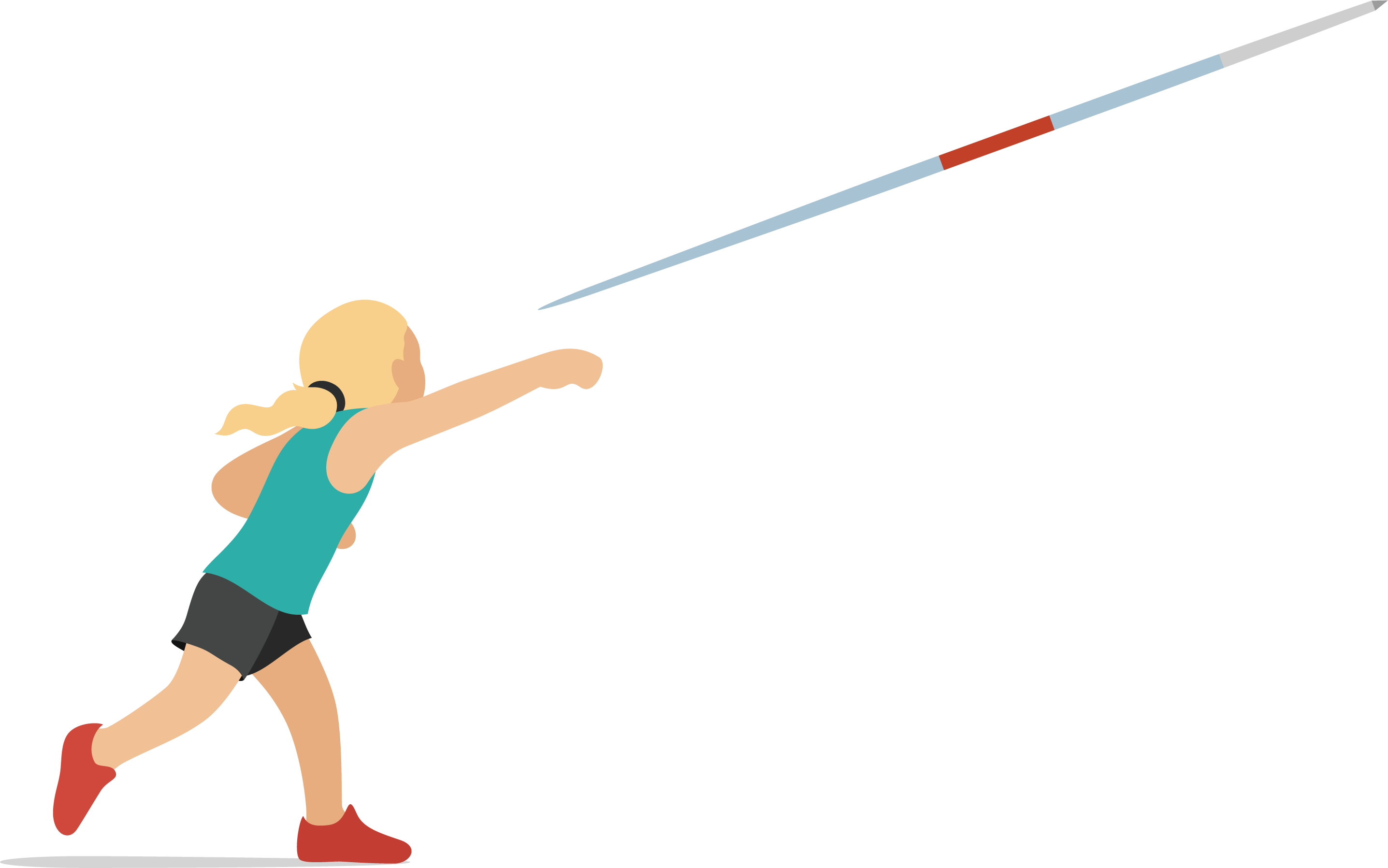Lesson 4
Metric Conversion and Division by Powers of Ten
Warm-up: True or False: Divide by a Hundred and a Thousand (10 minutes)
Narrative
Launch
- Display one equation.
- “Give me a signal when you know whether the equation is true and can explain how you know.”
- 1 minute: quiet think time
Activity
- Share and record answers and strategy.
- Repeat with each equation.
Student Facing
Decide if each statement is true or false. Be prepared to explain your reasoning.
- \(5 \div 1,\!000 = 0.05\)
- \(36 \div 100 = 0.36\)
- \(1,\!328 \div 1,\!000 = 1.328\)
Student Response
For access, consult one of our IM Certified Partners.
Activity Synthesis
- “How did you find the value of \(1,\!328 \div 1,\!000\)?” (I thought of it as 1,328 thousandths and then wrote that as a decimal.)
Activity 1: Long Jump, Javelin Throw, and Shot Put (15 minutes)
Narrative
The purpose of this activity is for students to convert from a smaller metric length unit to a larger metric length unit. In this activity, students divide a three- or four-digit number by 100. The measurements in centimeters are whole numbers, but the converted measurements in meters are decimals. To find the value of the quotients, students may reason about the meaning of each place value and how that changes when the value is divided by 100. They may also reason that each place value has \(\frac{1}{10}\) the value of the place to its left so shifting two places to the right gives a value of \(\frac{1}{100}\) the value for each place (MP2, MP7).
Supports accessibility for: Conceptual Processing, Language, and Memory
Launch
- Groups of 2
- Display the table shown in the student workbook.
- “What do you notice? What do you wonder?” (Who are those people? What is a javelin? What is a shot put? What is the long jump? Some of the numbers are close. Why are the long jump numbers so much smaller?)
- Record responses for all to see.
- “This table shows the results from track and field events.”
Activity
- 2 minutes: quiet think time
- 10 minutes: partner work time
- Monitor for students who observe that when they convert the whole number distances in centimeters to meters they get decimals to the hundredth.
Student Facing
| athlete | long jump | javelin throw | shot put |
|---|---|---|---|
| Jackie Joyner-Kersee, USA | 727 cm | 4,566 cm | 1,580 cm |
| Sabine John, Germany | 671 cm | 4,256 cm | 1,623 cm |
| Anke Behmer, Germany | 678 cm | 4,454 cm | 1,420 cm |
- Below are some results Jackie Joyner-Kersee recorded in different events in 1988. Complete the table.
event centimeters meters long jump 727 javelin throw 4,566 shot put 1,580 - Which unit of measure is most helpful when you picture each distance, centimeters or meters? Explain or show your reasoning.
- Why do you think that the distances are measured to the nearest centimeter?

Student Response
For access, consult one of our IM Certified Partners.
Advancing Student Thinking
If students do not have a strategy, ask:
- “How many centimeters are in a meter? How many meters is 200 centimeters?”
- “What expression can you write to represent this relationship?”
Activity Synthesis
- Display:
\(727 \div 100 = 7.27\)
\(4,\!566 \div 100 = 45.66\)
\(1,\!580 \div 100 = 15.80\) - “What patterns do you notice?” (The measurements in centimeters are whole numbers but the measurements in meters are in hundredths. All the digits in the numbers are the same but they shifted 2 places to the right. So the 7 hundreds in centimeters is 7 ones in meters.)
- “Why does dividing by 100 represent how many meters are in the given centimeters?” (I know there are 100 centimeters in each meter so each centimeter is \(\frac{1}{100}\) of a meter.)
- “How did you find the result of 727 divided by 100?” (I went place by place. 7 hundreds divided by 100 is 7 ones. 2 tens divided by 100 is 2 tenths. 7 ones divided by 100 is 7 hundredths.)
- Invite students to share which unit of measurement they found most informative for these distances and why.
Activity 2: Hurdles (15 minutes)
Narrative
This activity continues the work of the previous activity as students convert from a smaller metric length unit to a larger one. Students are given several different conversions and multiple numbers for each set of conversions. They observe that dividing by 100 shifts each digit two places to the right while dividing by 1,000 shifts each digit three places to the right when they convert different units. This allows students to solidify their understanding that dividing by powers of 10 shifts each digit one place to the right for every power of 10 in the divisor (MP8).
This activity uses MLR1 Stronger and Clearer Each Time. Advances: Reading, Writing.
Launch
- Groups of 2
- “Work with your partner on the first three problems.”
Activity
- 5–7 minutes: partner work time
- “Now, you are going to work independently to show or explain whether you think Tyler’s strategy will always work.”
- 3–5 minutes: independent work time
Student Facing
- The table shows how many meters some students ran during a week. Complete the table to show how many kilometers each student ran.
student distance (meters) distance (kilometers) Diego 9,513 Clare 11,018 Priya 8,210 Andre 10,000 - What patterns do you notice in the table?
-
Below is Tyler’s strategy to divide a whole number by 10, 100, or 1,000.

Describe to your partner what Tyler means.
(Pause for teacher direction.)
- Why does Tyler’s strategy work? Will Tyler’s strategy always work? Explain or show your reasoning.
Student Response
For access, consult one of our IM Certified Partners.
Activity Synthesis
- “Share with your partner your response as to whether or not Tyler’s strategy will always work. Take turns being the speaker and the listener. If you are the speaker, share your ideas and writing so far. If you are the listener, ask questions and give feedback to help your partner improve their work.”
- 3–5 minutes: structured partner discussion
- Repeat with 1–2 different partners.
- If needed, display question starters and prompts for feedback.
- “Can you give an example to help show . . . ?”
- “Can you add a diagram, table, or representation to show . . . ?”
- “Revise your initial draft based on the feedback you got from your partners.”
- 2–3 minutes: independent work time
Lesson Synthesis
Lesson Synthesis
“Today we converted from smaller metric distance units to larger metric distance units. We noticed and explained patterns in numbers when they are divided by 10, 100, and 1,000.”
Display a table like this:
| kilometers | meters |
|---|---|
| 7,864 | |
| 2.037 |
“What are the missing values in the table? How do you know?” (7.864 kilometers and 2,037 meters. To get from meters to kilometers, I divide by 1,000 and to get from kilometers from meters I multiply by 1,000 because there are 1,000 meters in a kilometer.)
“How is converting from smaller meters to larger kilometers the same and how is it different from converting from larger kilometers to smaller meters?” (In both cases you keep the same digits, only their place values change and they change by 3 place values ;in both cases. When I go from meters to kilometers the digits shift 3 places to the right and when I go from kilometers to meters they shift 3 places to the left.)
Cool-down: Han’s Run (5 minutes)
Cool-Down
For access, consult one of our IM Certified Partners.